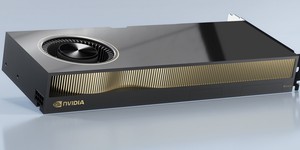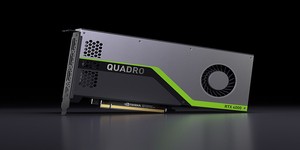
Nvidia has officially unveiled the Quadro RTX family of graphics cards, powered by its next-generation Turing architecture, which it somewhat inaccurately describes as 'the world's first ray tracing GPU.'
Revealed during a keynote presentation by founder and chief executive Jensen Huang during the SIGGRAPH 2018 conference, the Turing-powered Quadro RTX cards are designed to offer real-time ray tracing - a rendering method which casts and tracks rays of light, enabling considerably more realistic imagery at the cost of traditionally being too computationally intensive to perform in real time.
'Quadro RTX marks the launch of a new era for the global computer graphics industry,' claims Bob Pette, vice president of professional visualisation products at Nvidia. 'Users can now enjoy powerful capabilities that weren’t expected to be available for at least five more years. Designers and artists can interact in real time with their complex designs and visual effects in ray-traced photo-realistic detail. And film studios and production houses can now realize increased throughput with their rendering workloads, leading to significant time and cost savings.'
Nvidia's positioning of the card as the 'world's first ray tracing GPU,' though, isn't strictly speaking true: Caustic Graphics, acquired by Imagination Technologies in late 2010, announced its first ray tracing accelerator card, the CausticOne, in 2009, while 2013's Caustic R2500 increased the performance to fully real-time levels; rival Siliconarts, meanwhile, released its RayCore real-time ray tracing intellectual property (IP) in 2011.
Semantics aside, the Quadro RTX family of GPUs is certainly impressive: the entry-level Quadro RTX 5000 includes 16GB of Samung GDDR6 memory and can render at six gigarays per second (6GR/s) using its dedicated ray tracing cores (RT Cores); the mid-range Quadro RTX 6000 packs 24GB of memory and 10GR/s rendering performance; and the range-topping Quadro RTX 8000 includes 48GB of memory at the same performance level. All three cards support dual-GPU use with NVLink connectivity, effectively doubling the available memory.
While Nvidia's focus was on the use of the Quadro RTX for real-time ray tracing, the hardware also includes other tweaks: in addition to between 3,702 and 4,608 CUDA processing cores per card, depending on model, the Quadro RTX family also includes between 384 and 576 Tensor Cores, designed to accelerate deep-learning and other artificial intelligence tasks.
'Turing is Nvidia's most important innovation in computer graphics in more than a decade,' boasted Huang during the keynote. 'Hybrid rendering will change the industry, opening up amazing possibilities that enhance our lives with more beautiful designs, richer entertainment and more interactive experiences. The arrival of real-time ray tracing is the Holy Grail of our industry.'
The first Turing-based Quadro RTX cards will be available by the end of the year, Nvidia has confirmed, with US pricing set at $2,300, $6,300, and $10,000 'estimated street price' for the Quadro RTX 5000, RTX 6000, and RTX 8000 respectively (around £1,800, £4,930, and £7,820 respectively, excluding taxes.)

MSI MPG Velox 100R Chassis Review
October 14 2021 | 15:04








Want to comment? Please log in.